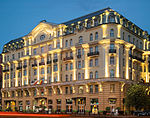Warszawa Śródmieście railway station

Warszawa Śródmieście railway station is a railway station in Warsaw, Poland, in the district of Śródmieście. The station serves the suburban (southern) tracks of the Warsaw Cross-City Line and is used by regional trains run by Koleje Mazowieckie (KM) and Szybka Kolej Miejska (SKM). There are two side platforms and one island platform serving two tracks, all located in a tunnel. It was built on the principle of the Spanish solution, whereas the centre platform would be using for the arriving passengers only and the side platforms for departing passengers only. The separation was enforced by access controls to the centre platform (discontinued in 1960s), location of ticket offices next to side platforms only, and opening trains' doors on the centre platform side first and on the side platform side with a delay. The separation was in operation until the 1980s.
Excerpt from the Wikipedia article Warszawa Śródmieście railway station (License: CC BY-SA 3.0, Authors, Images).Warszawa Śródmieście railway station
Pasaż Haliny Poświatowskiej, Warsaw Śródmieście (Warsaw)
Geographical coordinates (GPS) Address Nearby Places Show on map
Geographical coordinates (GPS)
| Latitude | Longitude |
|---|---|
| N 52.229444 ° | E 21.007778 ° |
Address
peron 2
Pasaż Haliny Poświatowskiej
00-697 Warsaw, Śródmieście (Warsaw)
Masovian Voivodeship, Poland
Open on Google Maps










